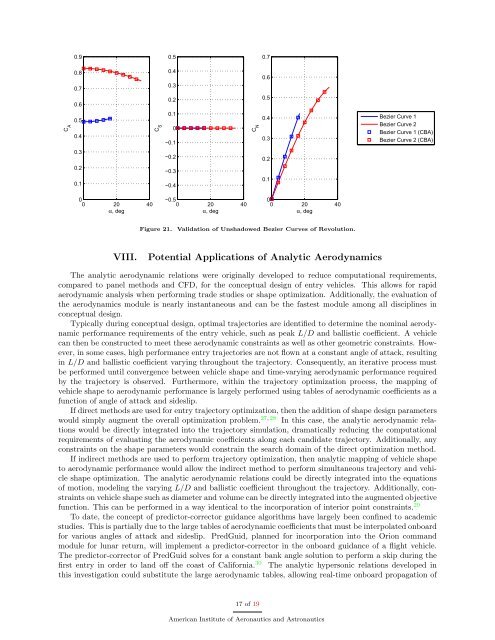Analytic Hypersonic Aerodynamics for Conceptual Design of Entry ...
Analytic Hypersonic Aerodynamics for Conceptual Design of Entry ...
Analytic Hypersonic Aerodynamics for Conceptual Design of Entry ...
Create successful ePaper yourself
Turn your PDF publications into a flip-book with our unique Google optimized e-Paper software.
C A<br />
0.9<br />
0.8<br />
0.7<br />
0.6<br />
0.5<br />
0.4<br />
0.3<br />
0.2<br />
0.1<br />
0<br />
0 20<br />
α, deg<br />
40<br />
C S<br />
0.5<br />
0.4<br />
0.3<br />
0.2<br />
0.1<br />
0<br />
−0.1<br />
−0.2<br />
−0.3<br />
−0.4<br />
−0.5<br />
0 20<br />
α, deg<br />
40<br />
C N<br />
0.7<br />
0.6<br />
0.5<br />
0.4<br />
0.3<br />
0.2<br />
0.1<br />
0<br />
0 20<br />
α, deg<br />
40<br />
Figure 21. Validation <strong>of</strong> Unshadowed Bezier Curves <strong>of</strong> Revolution.<br />
VIII. Potential Applications <strong>of</strong> <strong>Analytic</strong> <strong>Aerodynamics</strong><br />
Bezier Curve 1<br />
Bezier Curve 2<br />
Bezier Curve 1 (CBA)<br />
Bezier Curve 2 (CBA)<br />
The analytic aerodynamic relations were originally developed to reduce computational requirements,<br />
compared to panel methods and CFD, <strong>for</strong> the conceptual design <strong>of</strong> entry vehicles. This allows <strong>for</strong> rapid<br />
aerodynamic analysis when per<strong>for</strong>ming trade studies or shape optimization. Additionally, the evaluation <strong>of</strong><br />
the aerodynamics module is nearly instantaneous and can be the fastest module among all disciplines in<br />
conceptual design.<br />
Typically during conceptual design, optimal trajectories are identified to determine the nominal aerodynamic<br />
per<strong>for</strong>mance requirements <strong>of</strong> the entry vehicle, such as peak L/D and ballistic coefficient. A vehicle<br />
can then be constructed to meet these aerodynamic constraints as well as other geometric constraints. However,<br />
in some cases, high per<strong>for</strong>mance entry trajectories are not flown at a constant angle <strong>of</strong> attack, resulting<br />
in L/D and ballistic coefficient varying throughout the trajectory. Consequently, an iterative process must<br />
be per<strong>for</strong>med until convergence between vehicle shape and time-varying aerodynamic per<strong>for</strong>mance required<br />
by the trajectory is observed. Furthermore, within the trajectory optimization process, the mapping <strong>of</strong><br />
vehicle shape to aerodynamic per<strong>for</strong>mance is largely per<strong>for</strong>med using tables <strong>of</strong> aerodynamic coefficients as a<br />
function <strong>of</strong> angle <strong>of</strong> attack and sideslip.<br />
If direct methods are used <strong>for</strong> entry trajectory optimization, then the addition <strong>of</strong> shape design parameters<br />
would simply augment the overall optimization problem. 27, 28 In this case, the analytic aerodynamic relations<br />
would be directly integrated into the trajectory simulation, dramatically reducing the computational<br />
requirements <strong>of</strong> evaluating the aerodynamic coefficients along each candidate trajectory. Additionally, any<br />
constraints on the shape parameters would constrain the search domain <strong>of</strong> the direct optimization method.<br />
If indirect methods are used to per<strong>for</strong>m trajectory optimization, then analytic mapping <strong>of</strong> vehicle shape<br />
to aerodynamic per<strong>for</strong>mance would allow the indirect method to per<strong>for</strong>m simultaneous trajectory and vehicle<br />
shape optimization. The analytic aerodynamic relations could be directly integrated into the equations<br />
<strong>of</strong> motion, modeling the varying L/D and ballistic coefficient throughout the trajectory. Additionally, constraints<br />
on vehicle shape such as diameter and volume can be directly integrated into the augmented objective<br />
function. This can be per<strong>for</strong>med in a way identical to the incorporation <strong>of</strong> interior point constraints. 29<br />
To date, the concept <strong>of</strong> predictor-corrector guidance algorithms have largely been confined to academic<br />
studies. This is partially due to the large tables <strong>of</strong> aerodynamic coefficients that must be interpolated onboard<br />
<strong>for</strong> various angles <strong>of</strong> attack and sideslip. PredGuid, planned <strong>for</strong> incorporation into the Orion command<br />
module <strong>for</strong> lunar return, will implement a predictor-corrector in the onboard guidance <strong>of</strong> a flight vehicle.<br />
The predictor-corrector <strong>of</strong> PredGuid solves <strong>for</strong> a constant bank angle solution to per<strong>for</strong>m a skip during the<br />
first entry in order to land <strong>of</strong>f the coast <strong>of</strong> Cali<strong>for</strong>nia. 30 The analytic hypersonic relations developed in<br />
this investigation could substitute the large aerodynamic tables, allowing real-time onboard propagation <strong>of</strong><br />
17 <strong>of</strong> 19<br />
American Institute <strong>of</strong> Aeronautics and Astronautics

















